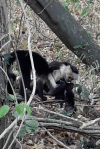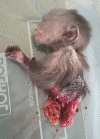Infant cannibalism in wild white-faced capuchin monkeys
- PMID: 33304485
- PMCID: PMC7713969
- DOI: 10.1002/ece3.6901
Infant cannibalism in wild white-faced capuchin monkeys
Abstract
Cannibalism has been observed in a variety of animal taxa; however, it is relatively uncommon in primates. Thus, we rely heavily on case reports of this behavior to advance our understanding of the contexts under which it occurs. Here, we report the first observation of cannibalism in a group of wild white-faced capuchin monkeys (Cebus imitator). The subject was a dead infant, estimated to be 10 days old, and the probable victim of infanticide. Consumption of the corpse was initiated by a 2-year-old male (second cousin of the infant), though it was eventually taken over and monopolized by the group's alpha female (grandaunt of the infant). Although most group members expressed interest in the corpse (sniffing, touching, and threatening it), no others made an attempt to consume it. Given that this is the only observation of cannibalism recorded in over 37 years of study on this population, we consider it to be a rare behavior in this species. This detailed record contributes new data, which, when combined with other reports within and across species and contexts, enables the evaluation of adaptive explanations of cannibalism.
Keywords: Cebusimitator; conspecific necrophagy; food sharing; infanticide; neophobia; thanatology.
© 2020 The Authors. Ecology and Evolution published by John Wiley & Sons Ltd.
Conflict of interest statement
None declared.
Figures
Similar articles
-
Female-committed infanticide followed by juvenile-enacted cannibalism in wild white-faced capuchins.Primates. 2021 Nov;62(6):1037-1043. doi: 10.1007/s10329-021-00949-z. Epub 2021 Oct 9. Primates. 2021. PMID: 34626294
-
Prolonged care and cannibalism of infant corpse by relatives in semi-free-ranging capuchin monkeys.Primates. 2020 Jan;61(1):41-47. doi: 10.1007/s10329-019-00747-8. Epub 2019 Sep 3. Primates. 2020. PMID: 31482322
-
Record of thanatology and cannibalism in drills (Mandrillus leucophaeus).Primates. 2023 Sep;64(5):475-481. doi: 10.1007/s10329-023-01075-8. Epub 2023 Jun 27. Primates. 2023. PMID: 37368091 Free PMC article.
-
Death among primates: a critical review of non-human primate interactions towards their dead and dying.Biol Rev Camb Philos Soc. 2019 Aug;94(4):1502-1529. doi: 10.1111/brv.12512. Epub 2019 Apr 4. Biol Rev Camb Philos Soc. 2019. PMID: 30950189 Review.
-
Callitrichid responses to dead and dying infants: the effects of paternal bonding and cause of death.Primates. 2020 Sep;61(5):707-716. doi: 10.1007/s10329-020-00824-3. Epub 2020 May 14. Primates. 2020. PMID: 32409994 Review.
Cited by
-
Carrying the dead: behavior of a primiparous capuchin monkey mother and other individuals towards a dead infant.Primates. 2025 May;66(3):241-247. doi: 10.1007/s10329-025-01187-3. Epub 2025 Apr 10. Primates. 2025. PMID: 40208487
References
-
- Aiello, L. C. , & Wells, J. C. K. (2002). Energetics and the evolution of the genus Homo . Annual Review of Anthropology, 31(1), 323–338. 10.1146/annurev.anthro.31.040402.085403 - DOI
-
- Buskirk, R. E. , Frohlich, C. , & Ross, K. G. (1984). ‘The natural selection of sexual cannibalism’, The American Naturalist . The University of Chicago Press, 123(5), 612–625. 10.1086/284227 - DOI
Associated data
LinkOut - more resources
Full Text Sources



